

Mr. Katsumi Asaba, who has been active in the forefront of advertising design as an art director, has an interest in the Tompa hieroglyphic characters that are handed down from one generation to the next in Lijiang in China. He has held a Tompa art exhibition and even produced a Tompa CD-ROM. TRON Project Leader Ken Sakamura asked Mr. Asaba about his fascination with Tompa characters.
________________________________________________________
Sakamura - You yourself write the very interesting characters called Tompa characters. What was it originally that was the starting point through which you took an interest in Tompa characters?
Asaba - Ten years ago, I wondered if people's consciousness wouldn't turn toward characters at the end of the century, and thus I created a club called the Tokyo Typedirectors Club. At present, this club has developed into an international exhibition; we are carrying out activities with the goal of one yearbook per year and one exhibition per year. At the time of the second exhibition, in Europe and America generally everything is unified with the alphabet, but when you look at Asia, the characters are different country by country--it is as if there is some deep wisdom there, and with that thinking I held an exhibition called the "Terrible Typography in Asia." At that time, I selected 22 types of representative characters of Asia and wrote and published the character for "a" in each of them. Among those, the mysterious ones called Tompa characters appeared, and I went off and investigated whether or not strange characters such as these really exist on this earth.
Sakamura - Tompa characters were the most interesting characters among those 22 types of characters, weren't they.
Asaba - That's 10 years ago. And then, when I investigated whether or not there was someone versed in these characters, there was Prof. Tatsuo Nishida, the former library director of Kyoto University. Prof. Nishida is also the person who deciphered HsiHsia characters, but I heard that he had also researched Tompa characters. Twenty-six years prior to that, he had also published a book from Chuo Koron titled Chikyuu saigo ikite iru tompa moji [The last Tompa characters alive on earth].
Sakamura - He published a book on Tompa characters 26 years ago.
Asaba - If we count from today, it's 36 years ago. That book is really interesting. In it, it is written ". . . regrettably, I have never gone to Lijiang where these Tompa characters are alive." And then, I visited Prof. Nishida. I went to meet him to ask "could I respectfully request you to accompany me to Lijiang?" At that, he said, "I'll go," "I'll take time off from school." I understand that he had been waiting for this chance for 26 years. And so I had the honor of him accompanying me for more than 10 days.
Sakamura - To Lijiang . . .
Asaba - Yes. Anyway, we went thinking there is no alternative other than going to the home where Tompa characters are alive.
Sakamura - Can you go directly to Lijiang?
Asaba - Now it has become very simple, but at that time I went to Kyoto to meet Prof. Nishida. We flew from Osaka to Shanghai. In Shanghai, we spent the night. Then we flew from Shanghai to Kunming. In Kunming, we spent the night. Next, we traveled overland, and then we spent the night at Dali. Finally, we raced for a day and at last we arrived at Lijiang.
Sakamura - It's tough just going there, isn't it.
Asaba - At the time, it took four days. Now we can fly by plane from Kansai International Airport to Kunming. Because we can fly by plane to Lijiang the following day after spending one night in Kunming, it has become possible to go there in two days.
Sakamura - And so what sort of place is this place called Lijiang?
Asaba - Today, it has also become a world legacy international city. The city is on a plateau 2,300 meters above sea level that is 50 kilometers from the Tibetan border.
Sakamura - Ten years ago, you encountered Tompa characters and in a heartbeat and you went to Lijiang, which is their home.
Asaba - I went suddenly, to the most interesting place. I'm thinking of trying to continue trips in search of the characters remaining on earth once a year. Even if I go to another location for some reason and think let's try searching a little for things about characters in our leisure time, there is definitely something like a soul to characters--they don't come into view.
Sakamura - Eh?
Asaba - When you go with another purpose, even if you think you'd like to search for them a little, you can't find them. When you say to someone, I've come for characters, they burst forth in front of your eyes.
Sakamura - If you don't go with a purpose, you can't see them them. When it's understood what you're aiming at is characters, they appear from those [who deal] with characters.
Asaba - Right, right. If it's not a case of you saying you've come to that country for characters, then it's fairly . . .
Sakamura - I see. To get back to the Tompa characters that you took an interest in 10 years ago, are these still in use even today?
Asaba - They are in use even today. In China, there is a thing called the Dongba Culture Research Institute. Mao Tse-tung banned religious-like things. Nevertheless, it survived. Because they said this is something that is terribly precious, the Dongba Culture Research Institute was created 20 years ago. At that time, it seems like there were about 20 Tompas, but at present there are only two old Tompas (Lao Dongba). They are 20 years old and 80 years old. They haven't already died off completely.
Sakamura - What! Two people!
Asaba - However, recently there was the First International Tompa Conference, and 100 hiding Tompas appeared.
Sakamura - Eh? An international conference! Where?
Asaba - It was held in Lijiang in October of 1999. And then, as many as 100 people appeared, although there were also a few phoney Tompas (laughs).
Sakamura - Is the pronunciation of Tompa characters the same as Chinese?
Asaba - No, it's the Naxi [NA-shi] language that the Naxi people possess. This is difficult, also.
Sakamura - That seems difficult. Tompa characters are the Naxi language put into characters. Isn't there anything else that is the Naxi language put into characters?
Asaba - They seem to be doing that also at present with Chinese. They seem to be doing this by replacing them with Chinese characters.
Sakamura - Well then, when the people who speak the Naxi language do things, are Tompa characters exactly what you would call the correct way?
Asaba - The correct way? When people read old stories or religious canons or when there is a festival, the Tompas come and read for people. Only the Tompas can read them.
Sakamura - By the way, as to what you call a Tompa, is there such a thing as a Tompa person?
Asaba - No, no. A Tompa is a shaman. A Tompa is a deity or a priest.
Sakamura - The characters those people use are called Tompa characters. Then they were the characters those noble people used in the past?
Asaba - Right, right.
Sakamura - From about how many years back have these been in existence?
Asaba - They say they have been in existence from 1,000 years ago. It's said from around the Tang dynasty. There is a thing called the Tompa canon. It made its way into America and Russia, but regrettably not even one volume has entered into Japan. Although Prof. Nishida wanted it, there was nothing he could do, and thus I understand that in the end he doesn't have it.
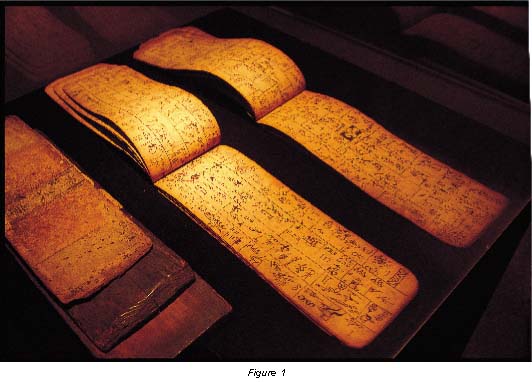
Sakamura - I understand we brought it on this occasion.
Asaba - You brought it (Fig. 1). I'd like to present a volume of this to Prof. Nishida the next time [I meet him]. The Chinese government has prohibited this from being taken out [of the country]. There's a reason for that. At the Dongba Culture Research Institute, the Tompas and the researchers got together and deciphered the stories. This was announced at the 20th anniversary commemoration, at the First International Tompa Conference. One thousand stories have been entered in 100 volumes.
Sakamura - That sounds like Tales of A Thousand and One Night [Arabian Nights].
Asaba - According to Prof. Nishida, the origin of the human race is the egg theory. I understand that's quite correct even if we look at it in terms of today's science.
Sakamura - What's the egg theory concerning the origin of the human race?
Asaba - If we call the human ovaries and such eggs, then it's because they are eggs. There are a lot of stories of that type, which are called kairuchin. Things such as the Book of Death also seem to be fairly detailed. The Tibetan Book of Death seems quite simple, but this is more complex. After dying, "when you turn that corner, you'll see a red persimmon tree; turn right there." A concrete Book of Death that gives those kinds of instructions to go to the Holy Land has been left behind. They say it also became a movie, but things such as a war between white and black--a lot of various stories have been left behind. Those are the results of the 20th anniversary; 100 volumes have appeared. Because all the stories, 1,000 stories, have appeared in them, it has come about that we no longer need the canon. There are actually several versions of the same canon. Since a well written canon was completely copied and made into 100 volumes, it comes down to a situation of asking if wouldn't it be all right if we took out a little [Tompa material].
Sakamura - I see.
Asaba - Antique dealers are in a dream. They go to the places of the hiding Tompas, look for Tompa materials, and bring them back. If you go to an antique dealer's shop, they say "feel my feet a little." When you feel them, they are full of calluses, and they intimidate you saying: "There are no hiding Tompas in the places where there are roads. I walked through mountain trails for three days or four days, where I visited them, and bought and brought these back. They're expensive, you know. How about it?" You don't make people feel your dirty feet, what (laughs)!
Sakamura - By the way, as to Tompa characters, about how many types of characters are there?
Asaba - There are roughly 3,000 types. And then, it seems like the Tompas are rapidly creating new characters.
Sakamura - That kind of thing also exists for Chinese characters, by the way.
Asaba - Since they are creators, they are rapidly creating times when meaning cannot be conveyed.
Sakamura - Are there also dictionaries?
Asaba - Dictionaries also exist.
Sakamura - Can you and Prof. Nishida read them?
Asaba - No, no. We still can't read them much yet.
Sakamura - Is there anyone in Japan who can read them?
Asaba - There is no one. At present, I may be the person who can read them the best.
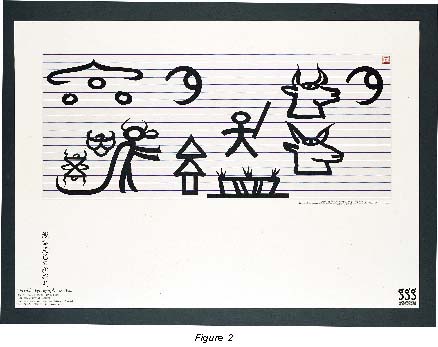
Sakamura - You use a method of reading that can't be imagined very much from the way we read characters, don't you.
Asaba - Right, right. The thing that looks like parentheses means sky (Fig. 2). We read it in this manner: "when the sky is high and full of stars, the gold and silver cannot be carried off on one's back." When we read the next, this time "when the ground is vast and the grass is lush, the oxen and sheep cannot be driven away." The thing that looks like the [waning] moon forms the negative.
Sakamura - The meaning seems very macro. They are not phonetic characters, in other words, they are not things like "a," or "i," or "u," rather they each possess meaning. Are these hieroglyphic characters?
Asaba - They are hieroglyphic characters. Therefore, all of them have ended up becoming concrete words. And then, subsequently, there seems to be improvising by the shamans. They have said that no matter how you read them, it seems to be all right.
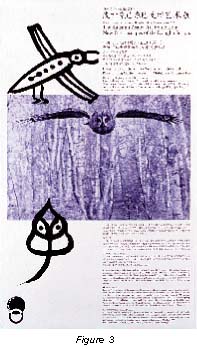
Sakamura - They have meaning, don't they. For example, what's this (bottom of Fig. 3). What sort of meaning does it have?
Asaba - That's a frog. Above that is a dragonfly. The method of abbreviating them is terribly well thought out. I am impressed to the point of believing that outstanding graphic designers existed 1,000 years ago.
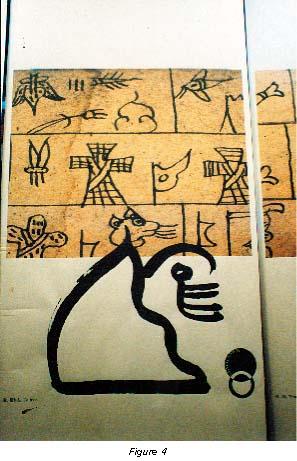
Sakamura - What's this one (Fig. 4)?
Asaba - That means to hide oneself. A person has hidden himself in the mountains. Because you get that impression, you understand the meaning of that character. I see, you say; you understand the fundamental point.
Sakamura - If that's the case, where is it for you that the fascination of Tompa characters lies?
Asaba - After all is said and done, they're interesting. And then, it seems like there is a place where the conceptual freedom of the graphic design lies a little beyond our grasp. I'd also like to thoroughly investigate who wrote these, but ultimately since it's already 1,000 years ago, the old Tompa of an old Tompa of an old Tompa wrote them.
Sakamura - Did a single person create all of these, or were they created by several people?
Asaba - I believe they gradually came into existence through several people spanning over several ages.
Sakamura - By the way, there is the fact that you have recently put out a Tompa character CD-ROM.
Asaba - I created that with the assistance of the Japanese government; I told them I somehow wanted to bequeath Tompa [characters]. And then, a budget was drawn up, and they were made in CD-ROM form. I introduce the culture of the Naxi people. Therefore, all of it is Asaba Tompa. That's because Asaba explains all about Tompa characters in it.
Sakamura - So this is a CD-ROM in which you explain Tompa characters.
Asaba - Right. And then things like the scenery and the customs. I do it on location, and, based on my diary, it is also made up like a travelogue that has moved in accordance with that.
Sakamura - This is interesting--images that are seen from a diary. Characters are also included, aren't they.
Asaba - One thousand three-hundred characters are included. Among 3,000 characters, there are the basic items--heavenly bodies, animals and plants, the movements of people, and so on. Overall, they are 1,300 characters for the items about which one would say, you should understand that.
Sakamura - I see.
Asaba - Three dictionaries have also appeared. As for one of them, a mysterious person called Dr. [Joseph] Rock, who was a botanist, a photographer, and a linguist, researched Tompa characters with the old Tompas using money from National Geographic magazine, but since the Communist Party entered the area, he fled to America. When he was riding on the boat to America, it was sunk by a Japanese submarine, and so he found his way back and secretly researched with the Tompas. Finally, the dictionary appeared from Italy about 15 years ago.
Sakamura - From Italy? Do Italians like them--these Tompa [characters]?
Asaba - No, I don't know, but that type of book making is something Italians like. As for another dictionary, an old Tompa called Li Lin-Ts'an fled to Taiwan and created a dictionary there. Therefore, there are two dictionaries at present, and furthermore recently there is another dictionary that appeared from Yunnan Province, which makes it three large dictionaries.
Sakamura - What you said about which dictionaries there are and so on is also introduced on that CD-ROM, isn't it.
Asaba - Yes.
Sakamura - Well then, this is something that's indispensable for people with an interest in Tompa characters. How much does it cost?
Asaba - It's about 8,800 yen. That's expensive, but music is also included. No dancing was filmed, but a ceremony was filmed through to the end. That type of thing is also there. There are all sorts of things that have been included.
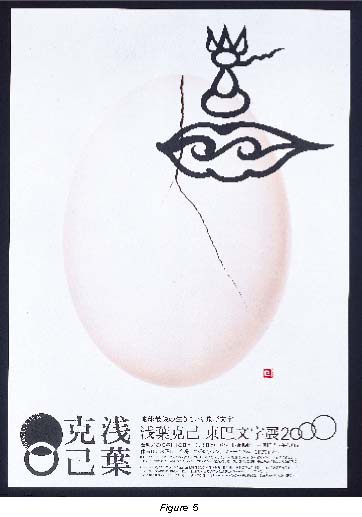
Sakamura - And then, another thing I'd like to ask you, in addition to putting out a CD-ROM, in conjunction with that, you just recently held the "Katsumi Asaba Tompa Character Exhibit" in Tokyo (Fig. 5). Will you exhibit this throughout Japan?
Asaba - I will exhibit it nationwide. If possible, I would like it to go to Korea and China. I was invited to the First Tompa International Conference, and I held an exhibition over there. It was held on the second floor of a place called Yüyinying, which is part of the ruins of an ancient castle called Mufu. That seems to have surprised the Chinese. They said things like why is it that a Japanese knows this type of thing, why is it that he writes these characters better than a Tompa? It was reported a lot in the papers over there. That because people came from Beijing and from all over the city.
Sakamura - In the TRON Project, a project to include your Tompa characters as a font among the 130,000 characters of Cho Kanji [the B-right/V R2 operating system] is steadily progressing. If these are included, it will be epochal.
Asaba - I wonder if that isn't a little selfish--on top of [Chinese] shell and bone inscriptions (laughs). Only I and Prof. Nishida know Tompa characters.
Sakamura - Ultimately, that's because TRON is a project that is attempting to completely include all the characters of the world up to the present.
Asaba - If these are included, I believe that the Chinese will be awfully interested. I believe it would be a case of them saying: Did our country have these kinds of characters? Minority peoples can't be made light of, can they.
Sakamura - Right, right. But since you said there are only two people today [who can read these characters], it's an incredibly small minority people.
Asaba - In the final analysis, the Jomon people [of Japan] were probably a characterless society. The fact was they didn't have any racial consciousness. Therefore, the Naxi people possess Tompa characters as their racial consciousness. In recent times, the Lijiang Naxi people learned of this. As a result, the town has become full of Tompa characters. Even the souvenir shops make plates! They make hanging scrolls! All sorts of things. Tompa are all over the place, from T-shirts, from costumes, from whatever--Tompa goods.
Sakamura - I would like to have you enter Tompa characters into BTRON and send them without fail to the world. I hope you will do this for us.
Asaba - Yes.
Sakamura - Thank you for today.
________________________________________________________
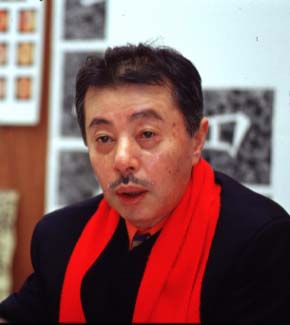
|
| Katsumi Asaba was born in Kanagawa Prefecture in 1940. In 1975, he set up the Asaba Design Co., and since then he has been active in the forefront of advertising design in Japan as an art director. Among his major commercials are those for Takeda Chemical Industries, Ltd. (Arinamin A); Suntory, Ltd.; Seibu Department Stores Ltd.; and Nissin Food Products Co., Ltd. (Cup Noodle). In 1987, he set up the Tokyo Typedirectors Club (TDC). With his eyes on the multifaceted character culture of Asia in particular, he held his first individual exhibition in 1990, where he announced new works based on Tompa characters and the like. In addition, he has done various types of design work, such as the official poster for the Nagano Olympics, and he serves as art director on the 2002 Soccer World Cup Invitational Committee. In 1995, he served as the art director for the film Sharaku for which he received the art award at the Japanese Academy Awards. |
________________________________________________________
|
| This CD-ROM consists of three parts: a documentary of a visit to the Lijiang district for the first time in nine years; Katsumi Asaba's typography creation knowhow and the Katsumi Asaba studio where 1,382 works are archived; and, an outline of Tompa characters in which the pronunciations of the characters have been collected for the first time in the world under the supervision of Kyoto University Professor Emeritus Tatsuo Nishida. A MPEG1 clip in excess of 60 minutes and precious still photographs bring the charm of Tompa characters to a higher level. The CD-ROM is made up so that anyone can become well versed in the mysterious world of Tompa characters. |
|
Does Lijiang and its culture sound interesting? If you would like more information on it, please click the link below. It leads to an English-language Web site that describes Lijiang and its culture, including its Tompa hieroglyphic characters.
http://www.jh.ynu.edu.cn/english/lijiang/lijiang.htm
The U.S. Library of Congress has a collection of 3,038 manuscripts in the Naxi language, making it the largest collection outside of China. The collection was described in the following article.
http://lcweb.loc.gov/loc/lcib/9906/naxi1.html
The following is an article in the China Daily News about a 50-volume set of The Completed Translated Works of Dongba Scriptures, which totals 45 million words.
http://www.peopledaily.com.cn/english/sbh/news/cd/dbwh614.htm
Katsumi Asaba now has his own Web page about Tompa characters, which is at the following URL.
The CD-ROM mentioned above was actually issued as a DVD-ROM. Here's the link to its Japanese description.
http://www.asaba-tompa.com/index04.html
The following link contains more examples of Tompa characters. Unfortunately, the readings are in Japanese.
http://www.asaba-tompa.com/index03.html
The above interview with Katsumi Asaba appeared on pages 10-17 in Vol. 62 of TRONWARE. It was translated and loaded onto this Web page with the permission of Personal Media Corporation.
Copyright © 2000 Personal Media Corporation
Copyright © 2000 Sakamura Laboratory, University Museum, University of Tokyo